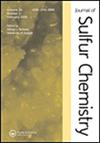2,2-二取代1,3-二硫代烷和1,3-草硫代烷中的C-S键被反式5-氢过氧-3,5 -二甲基-1,2-二氧代烷-3-酰基乙过氧化物生成的单线态分子氧氧化裂解
IF 1.6
3区 化学
Q3 CHEMISTRY, MULTIDISCIPLINARY
引用次数: 0
摘要
提出了一种合成上有用的1,3-二硫代烷和1,3-氧硫代烷保护基团脱保护的新方法。一系列2,2-二取代1,3 -二硫代烷和1,3 -草硫代烷被有效地脱保护,释放出相应的羰基化合物。在温和的室温条件下,反式5-羟基过氧基3,5-二甲基-1,2-二氧唑-3-基乙基过氧酸盐与KOH的组合是一种有效的C-S键氧化裂解体系。活性氧化物质是单线态氧分子。它是在KOH的作用下由反式5-羟基过氧基-3,5-二甲基-1,2 -二恶烷-3-酰基乙过氧酸酯裂解而生成的。本文章由计算机程序翻译,如有差异,请以英文原文为准。
Oxidative cleavage of C–S bonds in 2,2-disubstituted 1,3- dithiolanes and 1,3- oxathiolanes with singlet molecular oxygen generated from trans-5-hydroperoxy-3,5 dimethyl-1,2-dioxolan-3-yl ethaneperoxate
A new protocol for the synthetically useful deprotection of 1,3-dithiolane and 1,3-oxathiolane protected moieties has been developed. A series of 2,2-disubstituted 1,3 – dithiolanes and 1,3 – oxathiolanes was effectively deprotected to release the corresponding carbonyl compounds. The combination of trans-5-hydroperoxy-3,5-dimethyl-1,2-dioxolan-3-yl-ethaneperoxate and KOH was shown to be an effective system for the oxidative cleavage of C–S bonds under mild reaction conditions at room temperature. The active oxidizing specie is singlet molecular oxygen. It is generated via fragmentation of the trans-5-hydroperoxy-3,5-dimethyl-1,2 – dioxolane-3-yl ethaneperoxate with the help of KOH.
求助全文
通过发布文献求助,成功后即可免费获取论文全文。
去求助
来源期刊

Journal of Sulfur Chemistry
CHEMISTRY, MULTIDISCIPLINARY-
CiteScore
4.10
自引率
9.10%
发文量
38
审稿时长
6-12 weeks
期刊介绍:
The Journal of Sulfur Chemistry is an international journal for the dissemination of scientific results in the rapidly expanding realm of sulfur chemistry. The journal publishes high quality reviews, full papers and communications in the following areas: organic and inorganic chemistry, industrial chemistry, materials and polymer chemistry, biological chemistry and interdisciplinary studies directly related to sulfur science.
Papers outlining theoretical, physical, mechanistic or synthetic studies pertaining to sulfur chemistry are welcome. Hence the target audience is made up of academic and industrial chemists with peripheral or focused interests in sulfur chemistry. Manuscripts that truly define the aims of the journal include, but are not limited to, those that offer: a) innovative use of sulfur reagents; b) new synthetic approaches to sulfur-containing biomolecules, materials or organic and organometallic compounds; c) theoretical and physical studies that facilitate the understanding of sulfur structure, bonding or reactivity; d) catalytic, selective, synthetically useful or noteworthy transformations of sulfur containing molecules; e) industrial applications of sulfur chemistry; f) unique sulfur atom or molecule involvement in interfacial phenomena; g) descriptions of solid phase or combinatorial methods involving sulfur containing substrates. Submissions pertaining to related atoms such as selenium and tellurium are also welcome. Articles offering routine heterocycle formation through established reactions of sulfur containing substrates are outside the scope of the journal.
 求助内容:
求助内容: 应助结果提醒方式:
应助结果提醒方式:


